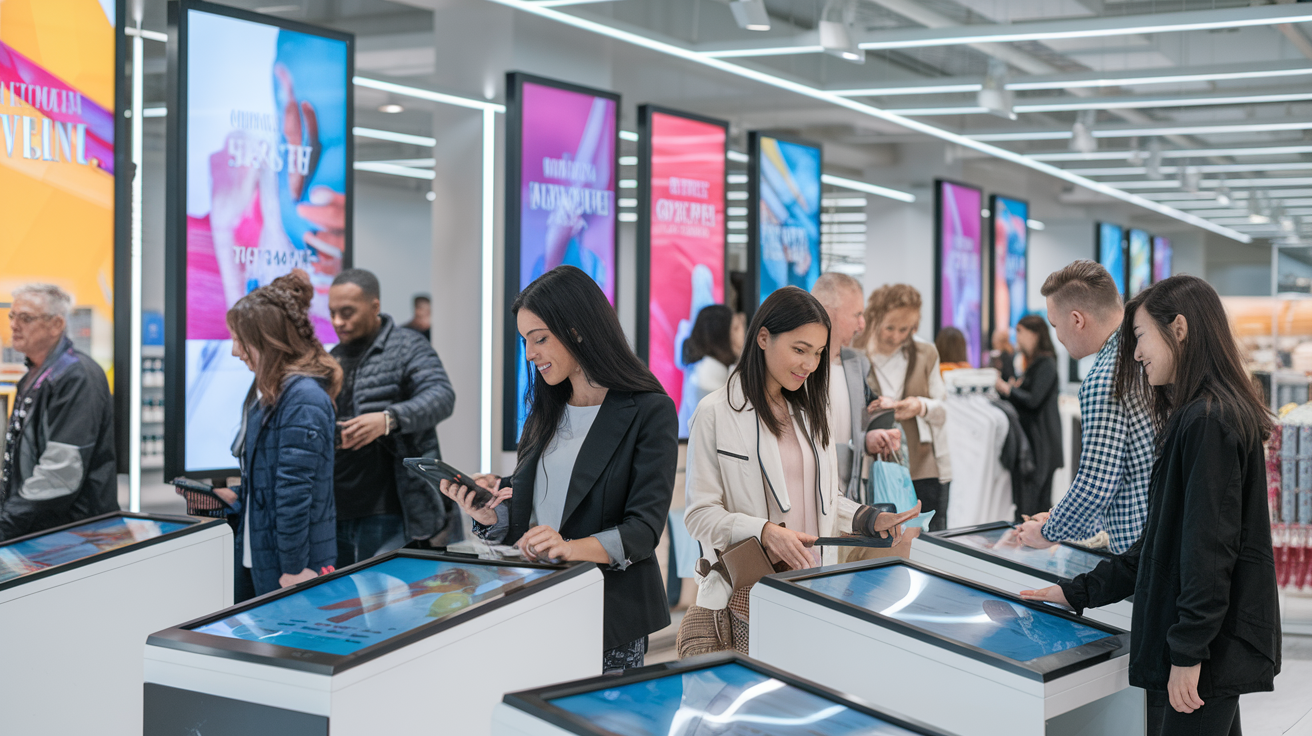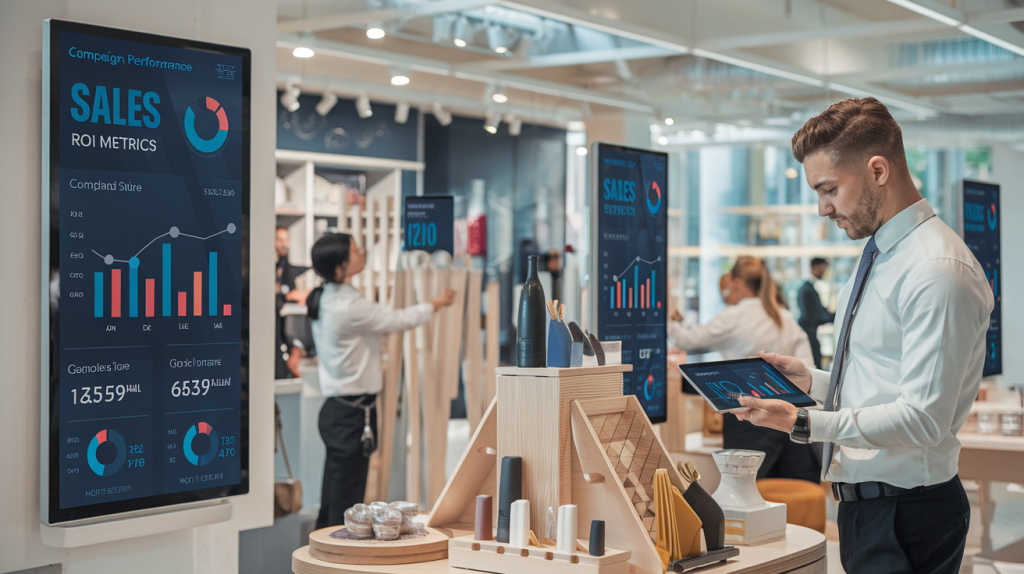
In today’s fast-paced retail landscape, capturing customer attention is more challenging than ever. With consumers bombarded by countless marketing messages daily, how can retailers stand out? The answer lies in a powerful yet often underutilized tool: Retail Digital Signage.
Imagine walking into a store and being greeted by vibrant, eye-catching displays that showcase products and tell a brand’s story. Picture dynamic promotions that adapt in real-time to customer behavior, creating an immersive shopping experience. This is the transformative power of Retail Digital Signage.
As we delve into the world of retail digital signage, we’ll explore how this technology is revolutionizing branding and promotions. From elevating brand visibility to boosting sales through dynamic promotions, we’ll uncover why digital signage has become an indispensable asset for retailers aiming to thrive in the modern marketplace.
Elevating Brand Visibility

Captivating customer attention
In the competitive retail landscape, capturing customer attention is crucial. Retail digital signage serves as a powerful tool to achieve this goal. Dynamic displays with vibrant visuals and engaging content instantly draw the eye, breaking through the noise of traditional static signage. These eye-catching screens can showcase products, promotions, and brand messages in high definition, creating a lasting impression on shoppers.
Reinforcing brand identity
Digital signage offers an unparalleled opportunity to reinforce brand identity consistently across all touchpoints. By displaying brand colors, logos, and messaging throughout the store, retailers can create a cohesive visual experience that strengthens brand recognition. This consistent branding helps build trust and familiarity with customers, ultimately fostering brand loyalty.
Creating immersive brand experiences
Retail digital signage enables the creation of immersive brand experiences that go beyond traditional marketing methods. Interactive displays allow customers to engage with products virtually, explore detailed information, and even visualize items in different settings. This level of engagement not only educates customers but also creates memorable experiences that associate positive emotions with the brand.
Enhancing store aesthetics
The implementation of digital signage significantly enhances store aesthetics, transforming the retail environment into a modern, sophisticated space. Sleek screens and captivating content contribute to a visually appealing atmosphere that aligns with contemporary consumer expectations. This enhanced ambiance not only attracts customers but also increases dwell time, potentially leading to higher sales and improved brand perception.
Boosting Sales through Dynamic Promotions

Real-time updates for time-sensitive offers
Retail digital signage enables retailers to instantly update promotional content, maximizing the impact of time-sensitive offers. This agility allows businesses to react quickly to inventory changes, competitor pricing, or sudden market shifts. By displaying real-time countdowns or limited-time deals, retailers create a sense of urgency that drives customer action and boosts sales.
Showcasing product features and benefits
Digital displays provide an engaging platform to highlight product features and benefits in a visually appealing manner. High-quality images, videos, and interactive content can effectively demonstrate product functionality, quality, and value proposition. This immersive presentation helps customers make informed decisions, increasing the likelihood of purchase.
Upselling and cross-selling opportunities
Retail digital signage excels at promoting complementary products or higher-margin alternatives. Strategically placed screens can suggest add-ons or upgrades based on customers’ current selections or shopping patterns. This targeted approach to upselling and cross-selling can significantly increase average transaction values and overall revenue.
Influencing impulse purchases
Dynamic digital content captures attention and stimulates impulse buying behavior. Eye-catching animations, vibrant visuals, and compelling offers can entice customers to make unplanned purchases. By strategically positioning digital signage near high-traffic areas or point-of-sale locations, retailers can effectively influence buying decisions and drive incremental sales.
Now that we’ve explored how digital signage boosts sales through dynamic promotions, let’s examine its role in enhancing the overall customer experience.
Improving Customer Experience

Reducing perceived wait times
Retail digital signage plays a crucial role in minimizing perceived wait times and enhancing customer satisfaction. By displaying engaging content, such as product showcases or brand stories, retailers can effectively distract customers from the passage of time. This strategy proves particularly beneficial in high-traffic areas like checkout lines or service counters, where customer patience is often tested.
Providing interactive product information
Interactive digital displays empower customers with instant access to detailed product information, specifications, and reviews. This self-service approach not only educates customers but also reduces the burden on staff, allowing them to focus on more complex inquiries. Customers can explore products at their own pace, comparing features and making informed decisions without feeling pressured.
Enhancing wayfinding in-store
Large retail spaces can be overwhelming for customers. Digital signage serves as an effective wayfinding tool, guiding shoppers to desired departments or products with ease. Dynamic, updatable maps and directional information ensure customers can navigate the store efficiently, reducing frustration and improving the overall shopping experience.
Entertaining customers while shopping
Retail digital signage transforms the shopping environment into an engaging, entertaining space. By showcasing branded content, social media feeds, or even live events, retailers can create a more immersive and enjoyable atmosphere. This entertainment factor not only enhances the customer experience but also encourages longer store visits, potentially increasing sales opportunities.
Cost-Effective Marketing Solution

Reducing print advertising costs
Retail digital signage offers a substantial reduction in print advertising expenses. Unlike traditional print materials that require constant reprinting and distribution, digital displays allow for instant content updates across multiple locations. This eliminates the need for recurring printing costs, shipping fees, and disposal of outdated materials. Retailers can significantly decrease their marketing budget while maintaining a fresh and relevant promotional strategy.
Streamlining content management
Digital signage simplifies content management for retailers. With centralized control systems, businesses can effortlessly update and distribute content across their entire network of displays. This streamlined approach allows for quick adaptation to market trends, inventory changes, or time-sensitive promotions. The ability to schedule content in advance further enhances efficiency, ensuring that the right message reaches customers at the optimal time.
Maximizing ROI through targeted messaging
Retail digital signage enables precise targeting of promotional content, maximizing return on investment. By leveraging data analytics and customer insights, retailers can tailor messages to specific demographics, time of day, or even weather conditions. This level of customization ensures that promotional efforts resonate with the target audience, increasing the likelihood of conversions and sales.
Minimizing labor costs for promotional updates
The implementation of digital signage significantly reduces the labor costs associated with promotional updates. Staff no longer need to spend time manually changing physical displays or hanging new posters. Instead, updates can be made remotely, freeing up employees to focus on customer service and other value-adding activities. This automation not only saves time but also ensures consistency across all store locations, maintaining brand integrity.
Adapting to Changing Consumer Behaviors
Meeting the expectations of tech-savvy shoppers
In today’s digital landscape, tech-savvy shoppers expect seamless, interactive experiences. Retail digital signage meets these expectations by providing dynamic, engaging content that resonates with modern consumers. These displays offer real-time information, product demonstrations, and interactive features that align with the digital-first mindset of today’s shoppers.
Integrating with mobile and social media
Retail digital signage enhances the omnichannel experience by integrating with mobile devices and social media platforms. Displays can showcase user-generated content, encourage social media engagement, and even allow customers to interact with products using their smartphones. This integration creates a cohesive brand experience across multiple touchpoints, reinforcing the retailer’s digital presence.
Personalizing content based on demographics
Advanced retail digital signage systems can leverage data analytics to deliver personalized content based on customer demographics. By analyzing foot traffic patterns, purchase history, and even facial recognition technology, retailers can tailor promotions and product recommendations to specific audience segments, increasing relevance and engagement.
Staying competitive in the digital age
As e-commerce continues to grow, brick-and-mortar retailers must innovate to remain competitive. Retail digital signage bridges the gap between online and offline shopping experiences, offering the flexibility and immediacy of digital content in a physical store environment. This technology enables retailers to quickly adapt to market trends, showcase new products, and create immersive brand experiences that set them apart from online-only competitors.
Measuring and Optimizing Performance

Analyzing customer engagement metrics
Retail digital signage provides valuable data on customer engagement, allowing retailers to measure the effectiveness of their promotional efforts. By tracking metrics such as dwell time, interaction rates, and conversion rates, businesses can gain insights into which content resonates most with their audience. These metrics help identify peak engagement periods and optimize content scheduling for maximum impact.
A/B testing promotional content
Digital signage enables retailers to conduct A/B tests effortlessly, comparing different promotional messages, designs or offers to determine which performs best. This data-driven approach allows for continuous refinement of marketing strategies, ensuring that displayed content maximizes customer engagement and drives sales. Retailers can quickly iterate on their promotional efforts, adapting to changing consumer preferences and market trends.
Adjusting strategies based on real-time data
The real-time nature of digital signage allows for dynamic adjustments to marketing strategies. Retailers can monitor performance metrics and make immediate changes to content, pricing, or promotions based on current sales data or foot traffic patterns. This agility ensures that promotional efforts remain relevant and effective, maximizing the return on investment for retail digital signage solutions.
Integrating with inventory management systems
By integrating digital signage with inventory management systems, retailers can automatically update promotions based on stock levels. This integration ensures that displayed content always reflects current product availability, reducing customer disappointment and optimizing sales opportunities. It also allows for the quick promotion of overstocked items or the highlighting of new arrivals, enhancing overall inventory management efficiency.
Conclusion
Retail digital signage has emerged as a powerful tool for retailers to enhance their brand visibility, drive sales, and create immersive customer experiences. By leveraging dynamic promotions, retailers can effectively capture customer attention and influence purchasing decisions. This versatile technology not only offers a cost-effective marketing solution but also enables businesses to adapt swiftly to changing consumer behaviors and preferences.
As the retail landscape continues to evolve, embracing digital signage is no longer a luxury but a necessity for staying competitive. By implementing this technology, retailers can measure and optimize their marketing efforts in real time, ensuring maximum impact and return on investment. To thrive in today’s digital age, retailers must recognize the transformative potential of digital signage and integrate it into their overall marketing strategy.